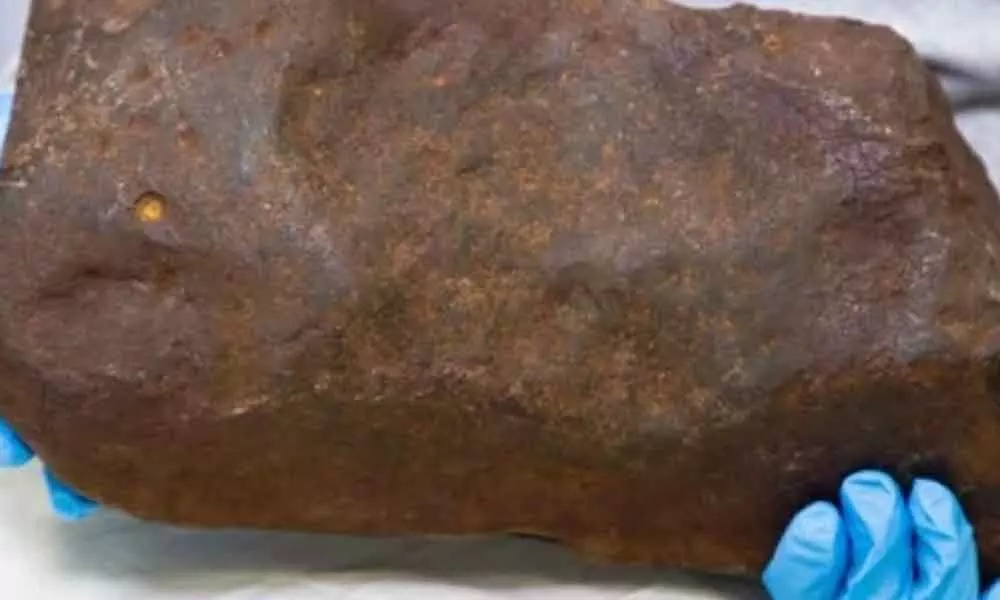Live
- Demand to release fee reimbursement dues
- Millet sisters take part in a host of programmes
- National conference on digital change begins at SU
- Mathematics plays key role in different fields
- Plaint filed against FRO for obstructing MGNREGA works
- Two students drown
- Udandapur Reservoir oustees assured of fair rehabilitation package
- IPS officers’ suspension extended for six months
- Endowments officials inspect Jogulamba temple amid allegation of mismanagement
- ‘Pending bills for village panchayats must be cleared immediately: Sarpanches
Man Keeps Rock For Years In The Hope Of Obtaining Gold While Ended Up To Be Much More Beneficial Than Gold After Discovery


Museums Victoria
- With the use of a metal detector, he noticed something unusual, after excavating he found a large, reddish rock sitting in some yellow soil.
- It turned out to be a rare meteorite, as he discovered years later.
David Hole was exploring in Melbourne, Australia, in Maryborough Regional Park in 2015, and with the use of a metal detector, he noticed something unusual, after excavating he found a large, reddish rock sitting in some yellow soil. He carried it home and attempted everything to open it, convinced that underneath the rock was a gold nugget as Maryborough is in the Goldfields area, where the Australian gold rush peaked in the nineteenth century. Hole attempted everything from a rock sawand angle grinder through a drill to dousing his treasure in acid to split it open. A sledgehammer, on the other hand, could not create a crack. That's because the object he was attempting to unlock was not a gold nugget. It turned out to be a rare meteorite, as he discovered years later.
Melbourne museum geologist Dermot Henry remarked that When they pass through the environment, they melted on the outside and are sculpted by the atmosphere. Hole took the nugget to the Melbourne Museum for confirmation, despite his inability to open the 'rock.' Henry claims that in his 37 years of serving at the museum and studying hundreds of rocks, only two of the gifts have ever proven to be genuine meteorites.
The researchers described the 4.6 billion-year-old meteorite in a scientific report, naming it Maryborough after the town where it was discovered. It weighs 17 kilograms (37.5 pounds), and after cutting off a short slice with a diamond saw, they determined that it contains a significant amount of iron, indicating that it is an H5 ordinary chondrite. When users open it up, people can see the tiny crystallized drops of metallic minerals called chondrules all over it. Henry said that meteorites are the most cost-effective way to explore space. They carry us back in time, revealing information about our Solar System's age, creation, and chemistry including Earth's.
Some of them give us a look into our planet's deepest recesses. There is 'stardust' even older than our Solar System in some meteorites, which demonstrates how stars develop and develop to produce elements of the periodic table. Organic compounds such as amino acids, which are the building blocks of life, are found in other uncommon meteorites.
The experts have made some educated predictions about where the meteorite came from and how soon it may have been on Earth.Solar System was a spinning heap of dust and chondrite rocks. Many of these materials were eventually gathered into planets by gravity, but the remainders generally ended up in a massive asteroid belt.
According to the researchers, the meteorite has been on Earth for between 100 and 1,000 years, and there have been a number of meteor sightings between 1889 and 1951 that could be related to its arrival. The Maryborough meteorite is far rarer than gold. It's one of just 17 meteorites ever discovered in Victoria, Australia, and it's the world's second-largest chondritic mass after a massive 55-kilogram specimen discovered in 20. This is only the 17th meteorite discovered in Victoria, but thousands of gold nuggets have been discovered. It is not the first meteorite to take several years to reach a museum. One space rock took 80 years, two owners, and a spell as a doorstop until being revealed for what it originally was.

© 2025 Hyderabad Media House Limited/The Hans India. All rights reserved. Powered by hocalwire.com






